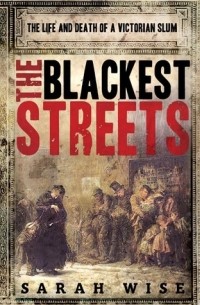Сара Уайз - все книги по циклам и сериям | Книги по порядку
-
The Blackest Streets: The Life and Death of a Victorian Slum Сара Уайз
ISBN: 0805075380 Год издания: 2010 Язык: Английский An enthralling account of the most notorious slum in Victorian England—and how it became a laboratory for "reforming" the poor
Condemned as a "fruitful hotbed of disease and death," the Old Nichol, a fifteen-acre East London slum, was a shameful blot on the age of progress. A maze of rotting hundred-year-old houses, the Old Nichol suffered rampant crime and a death rate four times that of London. Among the more piquant discoveries of an 1887 government inquiry was that the owners of these fetid dwellings included lords, lawyers, even churchmen.
Drawing on a rich archival store, Sarah Wise reconstructs the Old Nichol and the lives of its 6,000 inhabitants—the woodworkers, fish smokers, and dog dealers, whose tiny rooms doubled as workshops and farmyards. She depicts as well the eugenicists, anarchists, and philanthropists who ventured into the Old Nichol to "save" the poor with such theories as emigration and sterilization. The winning solution was demolition: the Old Nichol was replaced with a new, hygienic settlement—in which only eleven of the original residents could afford to live. Widely praised as a sensitive chronicler of the poor, Wise captures the moment when the poor turned from public nuisance into social experiment. -
The Italian Boy: A Tale of Murder and Body Snatching in 1830s London Сара Уайз
ISBN: 0805078495 Год издания: 2005 Издательство: Holt Paperbacks Язык: Английский "A work of great skill and sympathy, a meditation on one of the sorrowful mysteries once to be found on the streets of London. For any student of the city and its secret life, it is indispensable reading."
-Peter Ackroyd, The Times (London)
Before his murder in 1831, the "Italian boy" was one of thousands of orphans on the streets of London, begging among the livestock, hawkers, and con men. When his body was sold to a medical college, the suppliers were arrested for murder. Their high-profile trial would unveil a furtive trade in human corpses carried out by "resurrection men" who killed to satisfy the first rule of the cadaver market: the fresher the body, the higher the price.
Historian Sarah Wise reconstructs not only the boy's murder but the chaos and squalor of his world. In 1831 London, the poor were desperate and the wealthy petrified, the population swelling so fast that class borders could not hold. All the while, early humanitarians were attempting to protect the disenfranchised, the courts were establishing norms of punishment, and doctors were pioneering the science of anatomy.
As vivid and intricate as a novel by Charles Dickens, The Italian Boy restores to history the lives of the very poorest Londoners and offers an unparalleled account of England's great metropolis at the brink of a major transformation.


